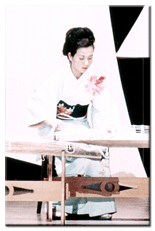
June’s sensei ~ Kazue Kudo
The koto is a traditional Japanese instrument that came to Japan from China around 700 AD. It was originally made from kiri (paulownia tree) that has heart-shaped leaves. It is a soft, porous wood that gives the deep, warm sound, like a harp (although it is classified under the zither family). It is approximately 6′-3″ long, 10″ wide and about 3″ deep. It has two sound holes at the bottom and is hollow inside. The traditional koto has 13 strings (originally silk, and now usually substituted with tetolon), with 13 moveable bridges (originally ivory but now also made of plastic). It is played with three ivory picks worn on the right hand. Some compare the koto to a dragon crouching by the sea because of its length. At the head of the dragon the strings are pulled down through eyelets, representing the horns of the dragon. At the opposite end the strings are coiled like the tail of a dragon. The bridges represent the scale of the dragon.
Jazz band Hiroshima’s master koto artist and free spirit, June Kuramoto, describes her journey and love for the koto~ June has performed with some of the greatest musicians in the classical world from Japanese masters to Ravi Shankar~
“To know (o)koto is to understand me and my love for this Japanese instrument. I was born in Japan but immigrated to America at the age of 6 with my mother, brother and two sisters. Facing the struggles and hardship of adapting to a foreign country, I longed to return to Japan. It was not much longer after our arrival in Los Angeles that was I introduced to the instrument. My family was attending a social/welfare event for immigrants, and I saw a woman perform on the koto. This woman sat at one end of the koto and when her fingers touched the strings, beautiful, harp-like sounds emanated throughout the hall. At that moment, I immediately fell in love with the sound and image. I begged my mother to let me play koto.
This woman playing this angelic sounding instrument was Kazue Kudo, who also had just immigrated to America. She was searching for a place to teach and was settling her life in a new country with her husband and three sons. My family’s living room became the “studio” where Kudo Sensei (teacher) initially taught in the Los Angeles area. I have studied classical, traditional koto with Kudo Sensei for over thirty years. I have also received my “natori” (teaching/professional/master degree) from the acclaimed Michio Miyagi Koto School of Japan.”





WowZa!!! – what a history of the koto and June’s connection to the instrument ~ i loved the description of the instrument, resembling a dragon crouching by the sea ~
Having grown up listening to the sounds of the santouri (Greek hammered dulcimer),qanun (the middle eastern version of the santouri), cymbalom (another version played in Eastern Europe), zither and related instruments also helped me appreciate the beautiful sounds of the the koto ~
Thanks Coralinni!! 😀
P.S. ooo! – interesting side note….the koto is quite similar to the chinese Guzheng – which it derived from ~ amazing instruments!
Thanks Yannaki for sharing your reflections on the koto! June’s story and talent speaks to my heart in a personal way ~
She grew up in the Crenshaw district of Los Angeles which is where my Mom is from (my Dad grew up in Los Angeles too but his parents first immigrated to Hollywood and then to the San Fernando Valley), .. and one of my cousins on my Mom’s side of the family (who is half Asian and half European) went to school with June ~
June is a lovely spirit and wonderful talent and an inspiration ~
Wow! – even more cool history!! ~ thanks for sharin’ June’s humble beginnings and the special connection to June with your cousin going to school with her ~ That’s so awesome! ~ ;D